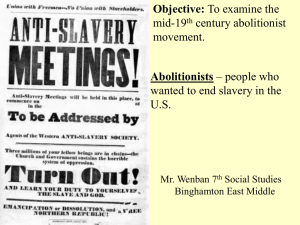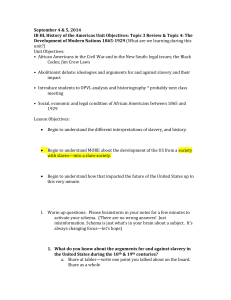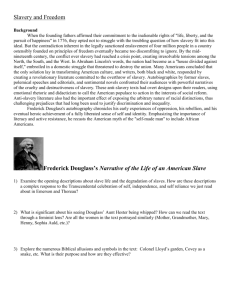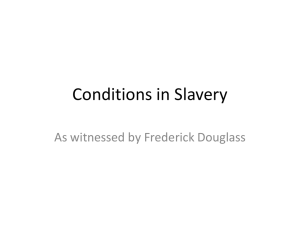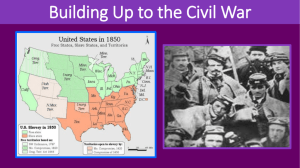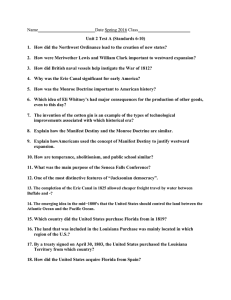Life of Reverend Thomas James, By Himself (1887)
advertisement
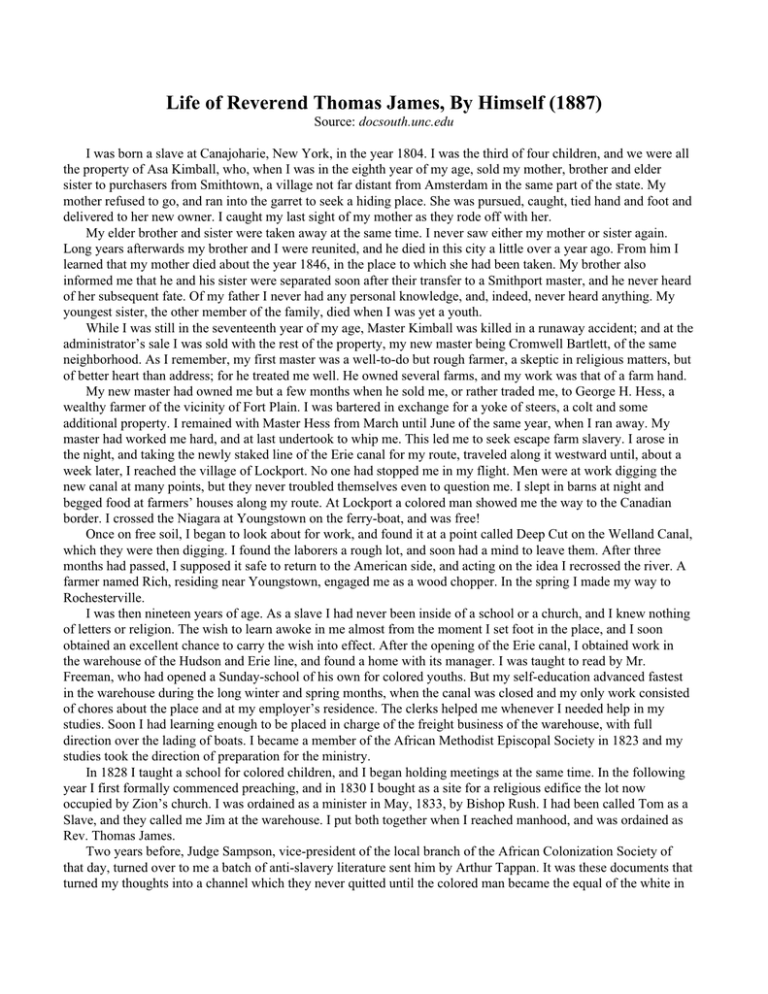
Life of Reverend Thomas James, By Himself (1887) Source: docsouth.unc.edu I was born a slave at Canajoharie, New York, in the year 1804. I was the third of four children, and we were all the property of Asa Kimball, who, when I was in the eighth year of my age, sold my mother, brother and elder sister to purchasers from Smithtown, a village not far distant from Amsterdam in the same part of the state. My mother refused to go, and ran into the garret to seek a hiding place. She was pursued, caught, tied hand and foot and delivered to her new owner. I caught my last sight of my mother as they rode off with her. My elder brother and sister were taken away at the same time. I never saw either my mother or sister again. Long years afterwards my brother and I were reunited, and he died in this city a little over a year ago. From him I learned that my mother died about the year 1846, in the place to which she had been taken. My brother also informed me that he and his sister were separated soon after their transfer to a Smithport master, and he never heard of her subsequent fate. Of my father I never had any personal knowledge, and, indeed, never heard anything. My youngest sister, the other member of the family, died when I was yet a youth. While I was still in the seventeenth year of my age, Master Kimball was killed in a runaway accident; and at the administrator’s sale I was sold with the rest of the property, my new master being Cromwell Bartlett, of the same neighborhood. As I remember, my first master was a well-to-do but rough farmer, a skeptic in religious matters, but of better heart than address; for he treated me well. He owned several farms, and my work was that of a farm hand. My new master had owned me but a few months when he sold me, or rather traded me, to George H. Hess, a wealthy farmer of the vicinity of Fort Plain. I was bartered in exchange for a yoke of steers, a colt and some additional property. I remained with Master Hess from March until June of the same year, when I ran away. My master had worked me hard, and at last undertook to whip me. This led me to seek escape farm slavery. I arose in the night, and taking the newly staked line of the Erie canal for my route, traveled along it westward until, about a week later, I reached the village of Lockport. No one had stopped me in my flight. Men were at work digging the new canal at many points, but they never troubled themselves even to question me. I slept in barns at night and begged food at farmers’ houses along my route. At Lockport a colored man showed me the way to the Canadian border. I crossed the Niagara at Youngstown on the ferry-boat, and was free! Once on free soil, I began to look about for work, and found it at a point called Deep Cut on the Welland Canal, which they were then digging. I found the laborers a rough lot, and soon had a mind to leave them. After three months had passed, I supposed it safe to return to the American side, and acting on the idea I recrossed the river. A farmer named Rich, residing near Youngstown, engaged me as a wood chopper. In the spring I made my way to Rochesterville. I was then nineteen years of age. As a slave I had never been inside of a school or a church, and I knew nothing of letters or religion. The wish to learn awoke in me almost from the moment I set foot in the place, and I soon obtained an excellent chance to carry the wish into effect. After the opening of the Erie canal, I obtained work in the warehouse of the Hudson and Erie line, and found a home with its manager. I was taught to read by Mr. Freeman, who had opened a Sunday-school of his own for colored youths. But my self-education advanced fastest in the warehouse during the long winter and spring months, when the canal was closed and my only work consisted of chores about the place and at my employer’s residence. The clerks helped me whenever I needed help in my studies. Soon I had learning enough to be placed in charge of the freight business of the warehouse, with full direction over the lading of boats. I became a member of the African Methodist Episcopal Society in 1823 and my studies took the direction of preparation for the ministry. In 1828 I taught a school for colored children, and I began holding meetings at the same time. In the following year I first formally commenced preaching, and in 1830 I bought as a site for a religious edifice the lot now occupied by Zion’s church. I was ordained as a minister in May, 1833, by Bishop Rush. I had been called Tom as a Slave, and they called me Jim at the warehouse. I put both together when I reached manhood, and was ordained as Rev. Thomas James. Two years before, Judge Sampson, vice-president of the local branch of the African Colonization Society of that day, turned over to me a batch of anti-slavery literature sent him by Arthur Tappan. It was these documents that turned my thoughts into a channel which they never quitted until the colored man became the equal of the white in the eye of the law, if not in the sight of his neighbor of another race. In the early summer of 1833 we held the first of a series of anti-slavery meetings in the court house. There was a great crowd in attendance on the first night, but its leading motive was curiosity, and it listened without interfering with the proceedings. The second night we were plied with questions, and on the third they drowned with their noise the voices of the speakers and finally turned out the lights. Not to be balked of his purpose, Mr. Bloss, engaged the session room of the Third Presbyterian church; but even there we were forced to lock the doors before we could hold our abolition meeting in peace. There we organized our anti-slavery society, and when the journals of the day refused to publish our constitution and by laws, we bought a press for a paper of our own and appointed the three leaders already named to conduct it. It was printed fort-nightly and was called The Rights of Man. I was sent out to make a tour of the country in its interest, obtaining subscriptions for the paper and lecturing against slavery. At LeRoy I was mobbed, my meeting was broken up, and I was saved from worse treatment only by the active efforts of Mr. Henry Brewster, who secreted me in his own house. At the village I next visited, Warsaw, I was aided by Seth M. Gates and others, and I was also well received at Perry. My tour embraced nearly every village in this and adjourning counties, and the treatment given me varied with the kind of people I happened to find in the budding settlements of the time. In the same fall I attended the first Anti-Slavery State Convention at Utica. In 1835 I left Rochester to form a colored church at Syracuse. Of course I joined anti-slavery work to the labor which fell upon me as a pastor. In the city last named the opponents of the movement laid a trap for me, by proposing a public discussion of the leading questions at issue. I was a little afraid of my ability to cope with them alone, and therefore, quietly wrote to Gerrett Smith, Beriah Green and Alvin Stewart for help. When the public discussion took place, and these practiced speakers met and answered the arguments of our opponents, the representatives of the latter, the leading editor and the foremost lawyer of the place, left the church in disgust. After their retreat from the hall, the two champions of slavery stirred up the salt boilers to mob us, but we adjourned before night, and when the crowd arrived at the edifice they found only a prayer meeting of the church people in progress, and slunk away ashamed. I was stationed nearly three years at Syracuse, and was then transferred to Ithaca, where a little colored religious society already existed. I bought a site for a church edifice for them, and saw it built during the two years of my stay in the village. Thence I was sent to Sag Harbor, Long Island, and, finally to New Bedford, Massachusetts. It was at New Bedford that I first saw Frederick Douglass. He was then, so to speak, right out of slavery, but had already begun to talk in public, though not before white people. He had been given authority to act as an exhorter by the church before my coming, and I some time afterwards licensed him to preach. He was then a member of my church. On one occasion, after I had addressed a white audience on the slavery question, I called upon Frederick Douglass, whom I saw among the auditors, to relate his story. Not long afterwards a letter was received from him by his fellow church members, in which he said that he had cut loose from the church; he had found that the American Church was the bulwark of American slavery. We did not take the letter to mean that Mr. Douglass had repudiated the Christian religion at the same time that he bade good-by to the churches.
